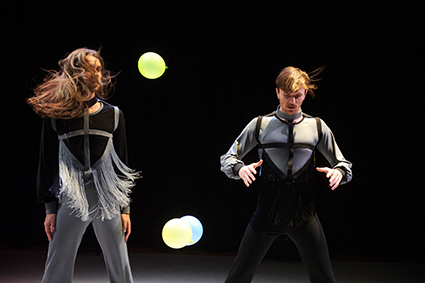Keeping track
Philipa Rothfield: Phantom Limbs’ Dreamlogic

James Andrews, James Welsby, Dreamlogic, Phantom Limbs, Dance Massive
photo Sarah Walker
James Andrews, James Welsby, Dreamlogic, Phantom Limbs, Dance Massive
“I liked the fact that I could not keep track of my dancing whilst talking and vice-versa.” Trisha Brown, talking during Accumulation plus talking plus Watermotor (1979);(recorded New York, September 1986).
As I lean forwards in my chair, I feel that my conscious intention is what animates this movement, that I am the one who initiates the move. While some of my actions are habitual and unthinking, I still have the sense that they are my actions, brought about by my implicit intentions. How do I know this? What do we really know about the way thought functions in the body?
Dreamlogic begins with a similar conundrum. A man (physicist Leonard Mlodinow) is heard speaking about science, neurons, experiments and the unconscious. Not the Freudian unconscious but an unconscious associated with brain activity. The suggestion is that there is a field of neural activity, perhaps very large, of which ‘we’ are not aware.
Dancers are, it seems to me, more inclined to accept the proposition that there is a bodily unconscious. Speaking about dancing Yvonne Rainer’s Trio A, Sara Rudner claimed, “When it came right down to it, you were there to do the dance; the best thing that happened was the body took over and the dance happened.” Improvisers likewise try to make space for new material to arise, beyond their conscious deliberation. Dance training also heavily depends upon habit-formation, which, once established, operates without the assistance of conscious supervision.
Dreamlogic locates itself within this bodily realm of movement sans consciousness. Two dancers (James Welsby and James Andrews) enter a space ringed by electric fans. They blow up balloons which they roll around their bodies. Perhaps the balloon represents a neuron or a networked form of agency that lies beyond the dancer’s awareness? The dancers adapt their movements to the dictates of the balloon. To that extent, their movement is not controlled by some sovereign consciousness.
Of all the different aspects of the human body, consciousness is the most elusive to explain in scientific terms. We are acquainted with our own conscious thoughts, but what do we know from a third person point of view, that is to say, objectively? MRI brain imaging has produced a lot of information about the brain, raising the status of neuropsychology within the field of psychology.
Dreamlogic takes up this question from a kinaesthetic point of view, raising the possibility of a movement unconscious or, as they put it, “can consciousness exist outside our brain’s concept of the body?” As the music begins, the two dancers execute a series of movements in mirror formation. This slowly shifts into another kind of repetition, towards subtle aspects of difference. One dancer executes a leg circle one way, the other the reverse. Perhaps this is an attempt to displace the linear logic of movement, to question our sense that time moves forwards. Lines are drawn across the body, movement patterns established, varied, doubled or decentred. Perhaps there is an abstract element to the dancing, the creation of movement patterns outside human expressivity. The balloons return, changing the quality of movement to the dictates of the spherical object.
Welsby and Andrews move towards the circle of electric fans onstage, turning them on in turn. The air movement from the fans circulates, keeping the balloons in a kind of Brownian motion. Many more balloons are added to the mix, creating beautiful and mesmerising swirls of activity. Ending with this poetics of neural activity, the dancers quietly leave.
To what extent can we say that human actions occur at an unconscious level? There was I think an opportunity to investigate these ideas at a choreographic, performative level, in terms of the dancing itself. By and large, the set movements in Dreamlogic were performed in a knowing manner: choreographically, the dancers knew what was coming, what they were doing and basically did it. The balloons formed a kind of exception, in that the body had to adapt to their motion. There are ways to make work where the choreographic demands necessarily exceed the dancer’s conscious intentionality, for example Trisha Brown’s Accumulation with Talking plus Watermotor (quoted above). It would have been interesting to watch the dancers in Dreamlogic grapple with these issues in performative terms, towards a sense of the unconscious in motion.
Phantom Limbs, DREAMLOGIC, creators James Welsby, Amy Macpherson; performers James Welsby, James Andrews, Darebin Speakeasy, Northcote Town Hall, 6-10 March
RealTime issue #126 April-May 2015 pg. 25






